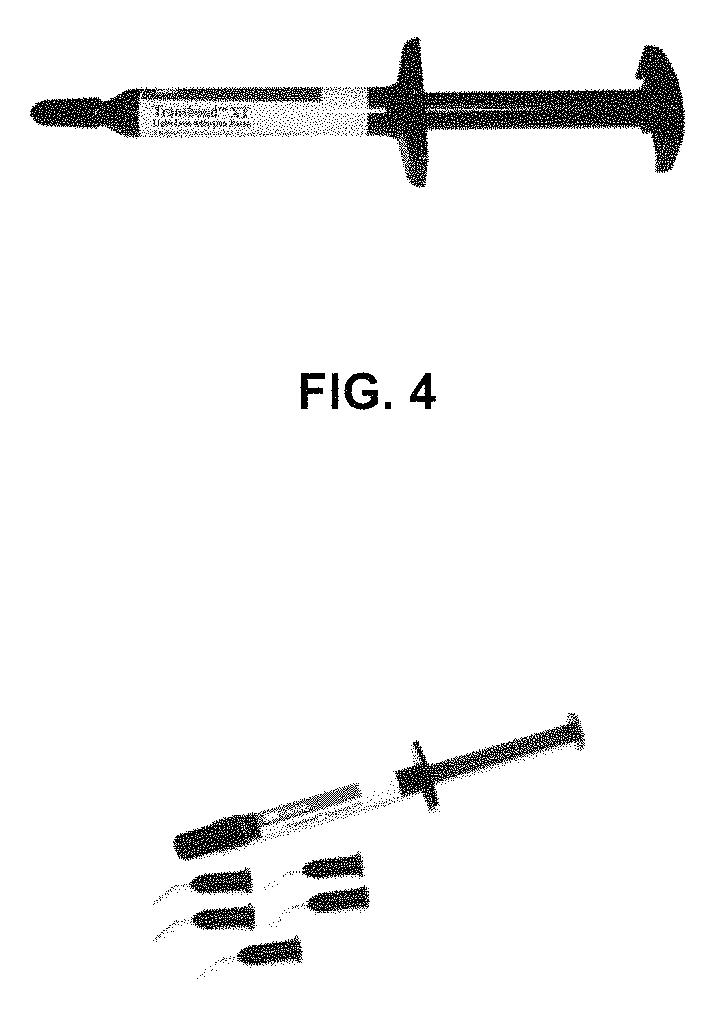BisGMA-free orthodontic adhesives
a technology of adhesives and bisgma, applied in the field of attachments and reagents used in orthodontics, can solve problems such as estrogenic effects, mechanical damage of polymers, chemical degradation,
- Summary
- Abstract
- Description
- Claims
- Application Information
AI Technical Summary
Benefits of technology
Problems solved by technology
Method used
Image
Examples
example 1
or Obtaining the Adhesives
[0143]Adhesive for One-Step:
[0144]Monomer trimethylolpropane trimethacrylate (TMPTMA) 40.67% (w / w) with initiator camphoroquinone 0.3% were mixed. When viewing a homogeneous mixture the photo-activator Dimethyl p-toluidine 0.03% was added, then, the nanometric silicon dioxide (325 microns) up 57%, to finish with nanometric silicon dioxide (16 nm) 2%. After obtaining a homogeneous mixture, it was stored in an amber bottle, labeled with the number and date of the mixture preparation. The mixtures were made into a chamber illuminated with security light to prevent polymerization.
[0145]Adhesive System:
[0146]a) Primer: the monomer was mixed with the accelerator (later the solvent (10% isopropyl alcohol) was added, mixing in a closed vessel to avoid evaporation. When viewing a homogeneous mixture, the photoactivator (camphoroquinone 0.3%) was added. Then the silicon dioxide (silanized silicon dioxide with nanometer particle size (16 nm) 6% silicon) was added. Aft...
example 2
tion of Hardening Time
[0148]The hardening time of the adhesive was determined by placing a drop of adhesive in a stainless steel mold of 4 mm in diameter and 1 mm of thick with teflon spatula until rasar it; It was irradiated with a light source (previously assessed as to irradiation: 600 mW / cm2) for 5 seconds. Subsequently, a perpendicular force was applied to penetrate the adhesive using a micrometer screw with a sharps attachment. If the adhesive was not yet hardened, another drop of adhesive was placed in the mold and was photopolymerized for 10 seconds, the procedure of indentation was performed. The total procedure is repeated until immersed hardening material into the mold. FIG. 10 shows the test sequence. The hardening time of each adhesive mixture is shown in the graph of FIG. 11 and averages in the graph of FIG. 12.
example 3
tion of Peel Strength
[0149]To determine the peel strength, elastic modulus and maximum stress supported by the adhesive were calculated, for which was carried out the following protocol:
[0150]Human teeth were used for each group numbered as (1) Adhesive of the invention, 2) Adhesive A, 3) Adhesive C and 4) Adhesive B. The teeth were washed by removing the periodontal ligament, were stored in water and chilled at 5±2° C. until use.
[0151]The teeth were cut 5 mm apical of the line of cement-enamel junction (below the anatomical crown) to locate the anatomical center line at the center of the cylinder (sample holder). Prophylaxis was performed on the buccal surface of the teeth with rubber cup and fluoride-free prophylaxis paste, washed with pressurized water and dried with compressed air, free of oil.
[0152]Teeth carried adhesives of the invention (experimental) were wiped with phosphoric acid diluted in water to 37%, with a micro-brush on the adhesion area for 15 seconds; washed and dr...
PUM
| Property | Measurement | Unit |
|---|---|---|
| particle size | aaaaa | aaaaa |
| particle size | aaaaa | aaaaa |
| elastic modulus | aaaaa | aaaaa |
Abstract
Description
Claims
Application Information
 Login to View More
Login to View More - R&D
- Intellectual Property
- Life Sciences
- Materials
- Tech Scout
- Unparalleled Data Quality
- Higher Quality Content
- 60% Fewer Hallucinations
Browse by: Latest US Patents, China's latest patents, Technical Efficacy Thesaurus, Application Domain, Technology Topic, Popular Technical Reports.
© 2025 PatSnap. All rights reserved.Legal|Privacy policy|Modern Slavery Act Transparency Statement|Sitemap|About US| Contact US: help@patsnap.com



